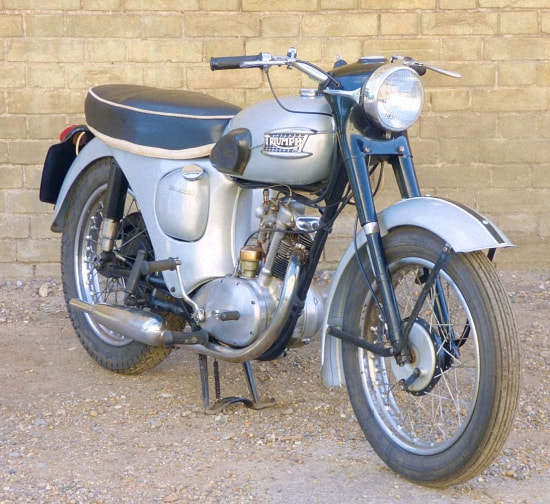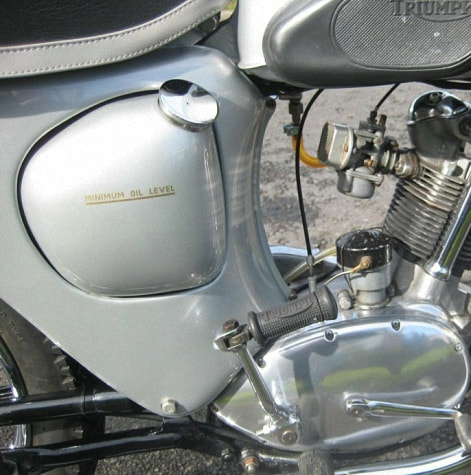Tiger Cub T20 (& T20J) 1959
A major styling change happened with the 1959 model which mirrored to some extent the styling on some of Triumph's larger machines, but instead of full enclosure rear panels the Tiger Cub's were more conservative. From the rear of the crankcase they swept up in a sort of triangle shape surrounding the oil tank on the right and the tool/battery box on the left before finishing just short of the far end of the seat.
Unfortunately there were a number of drawbacks with the design, particularly with draining the oil tank during oil changes. A different shape oil tank was required to accommodate the right hand panel and the new design didn't have a drain plug, necessitating either removal of the panel to disconnect the oil pipes for draining there, or reaching underneath the engine to remove the oil junction assembly. If the oil tank required fully cleaning out, the side panel had to come off anyway. A fiddly job at the best of times due to lack of space around the fasteners and which, if undertaken without care, would leave scratches on the oil tank, tool box and the panels themselves. Because of this, just how many owners neglected to carry out regular oil changes is one of conjecture, but there must have been a number.
One other noticeable styling change was to the petrol tank. A new shape three gallon item that was to stay with the Tiger Cub until production ended.
Unfortunately there were a number of drawbacks with the design, particularly with draining the oil tank during oil changes. A different shape oil tank was required to accommodate the right hand panel and the new design didn't have a drain plug, necessitating either removal of the panel to disconnect the oil pipes for draining there, or reaching underneath the engine to remove the oil junction assembly. If the oil tank required fully cleaning out, the side panel had to come off anyway. A fiddly job at the best of times due to lack of space around the fasteners and which, if undertaken without care, would leave scratches on the oil tank, tool box and the panels themselves. Because of this, just how many owners neglected to carry out regular oil changes is one of conjecture, but there must have been a number.
One other noticeable styling change was to the petrol tank. A new shape three gallon item that was to stay with the Tiger Cub until production ended.
|
Engine-wise and to aid cooling, a new oval shape cylinder head and barrel was fitted with a corresponding increase in fin area, and in the exhaust department a larger silencer still was fitted; again in an attempt to quieten down the machine's exhaust note. Carburettor for this year was the Zenith 17MXZ-CS5. Machine colour continued with the Crystal Grey and black livery (UK and other markets) and Aztec Red and black (USA). |
The T20J Junior Cub of 1959 mirrored all the changes to the standard T20 Cub but kept either the restrictor between the carburettor and cylinder head or was fitted with a small bore 9.5mm Zenith instrument.
Specifications for 1959 T20 model
Engine
Type: Single-cylinder OHV, unit construction
Capacity: 199cc (12.1 cu in)
Bore/Stroke: 63mm (2.480in) x 64mm (2.520in)
Compression: 7:1
Power: 10bhp (7.5 kW or 10.1 PS) @ 6000 rpm
Carburettor: Zenith 17MXZ-CS5 (with restrictor or Zenith 9.5mm MXZ for T20J)
Camshaft: Standard - valve clearances In & Ex 0.010in (cold)
Clutch: Wet multiplate
Gears: 4
Cycle Parts
Front Suspension: Telescopic forks, hydraulic damped
Rear Suspension: Swing-arm
Front Wheel: 16 inch (WM2 rim)
Rear Wheel: 16 inch (WM2 rim)
Front Tyre: 3.25 x 16
Rear Tyre: 3.25 x 16
Brakes: 5.5 in dia. Single leading shoe drum front and rear
Petrol Tank: 3 gallons (13.5 litres)
Oil tank - 2 3/4 pints
Gearbox - 1/3 pint
Primary chaincase - 1/3 pint
Front Fork: 1/8 pint
Electrics
Type: Lucas Ignition Coil
Voltage: 6
Charging Type: Alternator / Rectifier
Ignition Timing: 4 degrees BTDC static. 28 degrees fully advanced
Points Gap: 0.014in - 0.016in
Spark Plug: Champion L7 or equivalent
Spark Plug Gap: 0.025in


